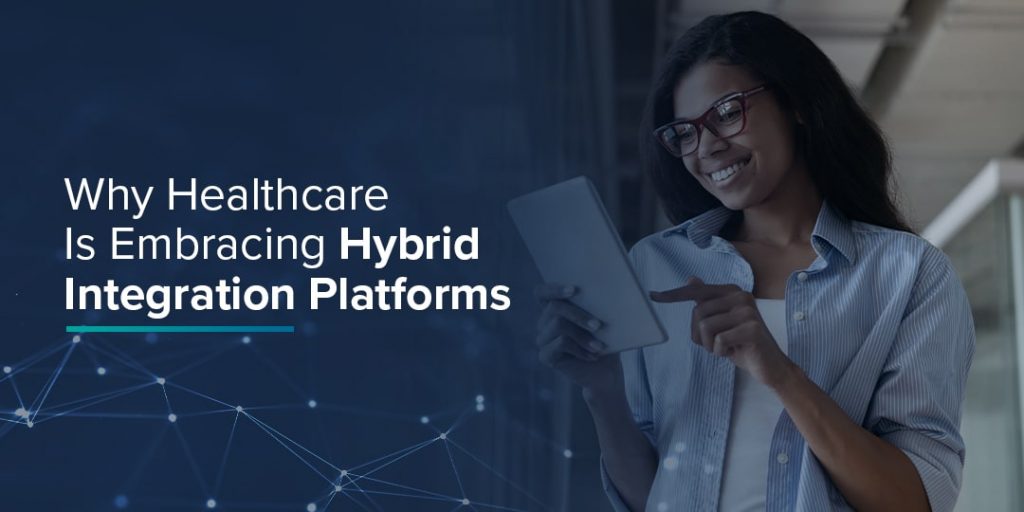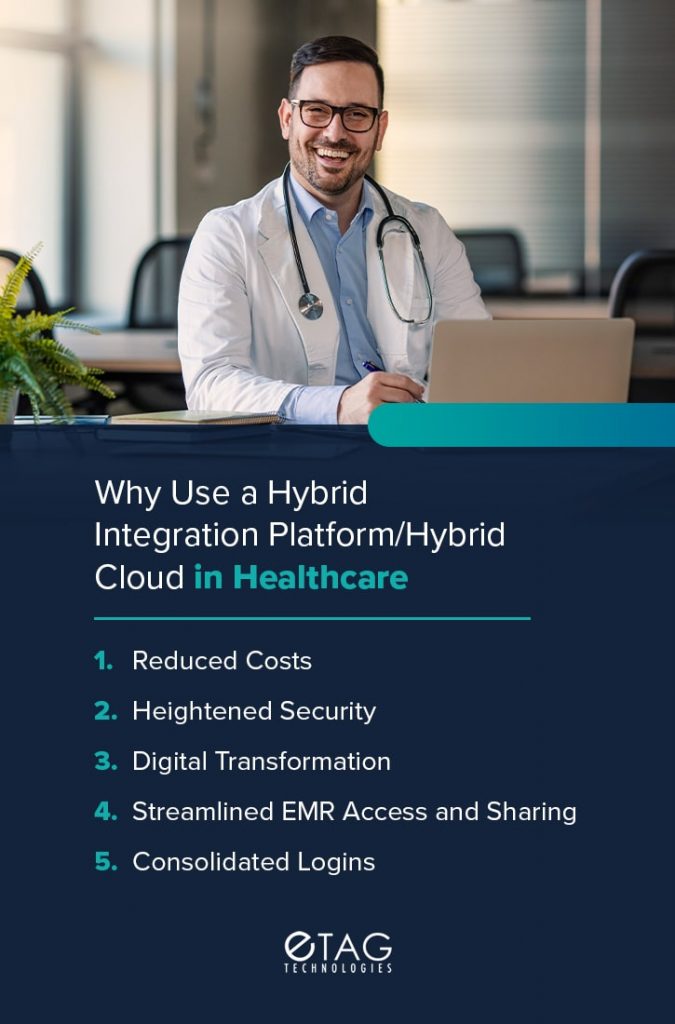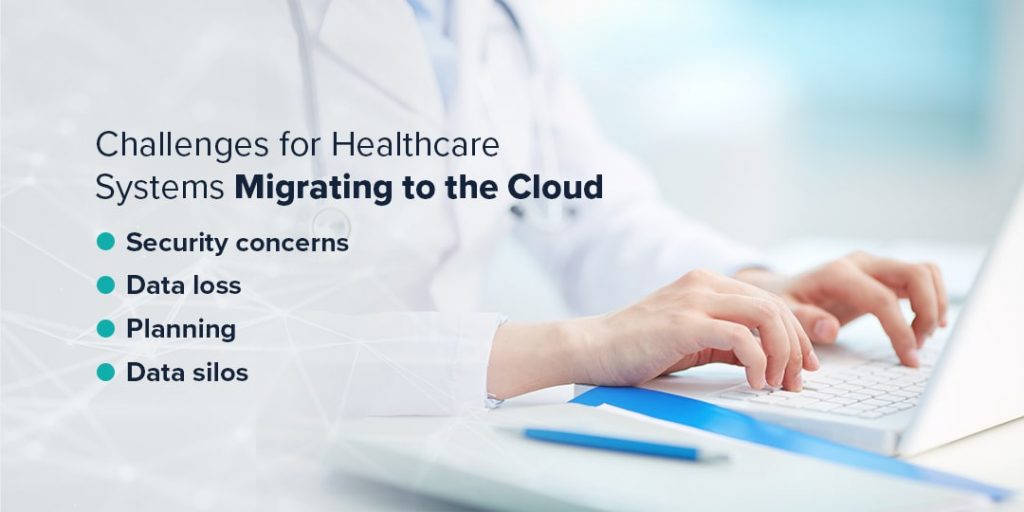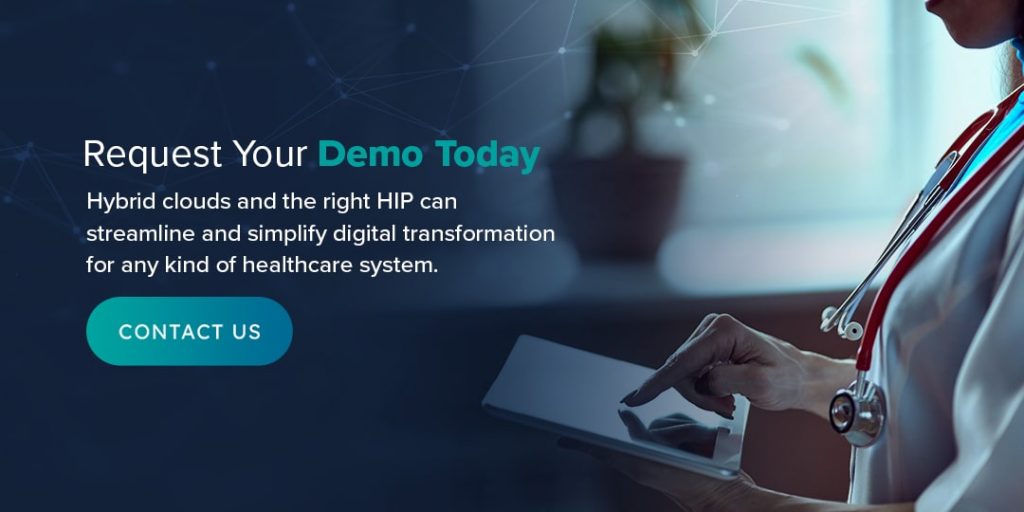Why Healthcare Is Embracing Hybrid Integration Platforms


As the healthcare IT landscape rapidly evolves, data management has to evolve with it.
The cloud’s next-generation tools and efficient data access make it an enticing option, but many healthcare organizations have a slew of legacy systems that don’t work well with that kind of architecture. Further, cloud-based systems can present some risk for organizations that lack the resources to maintain the healthcare industry’s strict security demands. Some businesses are turning to hybrid clouds to get the best of both worlds, but with so many applications and systems involved in large healthcare operations, developing a hybrid environment calls for careful integration.
Enter the hybrid integration platform (HIP). HIPs are powerful resources that allow healthcare organizations to take advantage of the cloud — public, private or both — while maintaining on-premise solutions and other data architectures in a simplified, streamlined environment for optimal performance. With benefits that span costs, security, outcomes and even employee retention, HIP has much to offer.
What Is a Hybrid Integration Platform?
A hybrid integration platform brings together the diverse applications that healthcare systems use and puts them under one umbrella, improving security and reducing complexity.
These organizations need to balance a complicated collection of different tools — they might mix and match new and legacy systems, on-premise and cloud storage and other types of solutions. At the same time, they need to communicate with various other entities, like labs, imaging services and government registries. Some types of data demand stricter security standards than others, but all of them call for high levels of reliability, interoperability and scalability.
HIPs can help streamline many applications and help healthcare organizations gain a competitive edge and improve health outcomes, all while increasing security and reducing operating costs. This platform is a cohesive set of integration and data management tools built to bridge on-premise and cloud solutions.
Some tasks that health information platforms can help with include:
- Standardizing and centralizing data: With so many sources, HIPs accomplish the vital task of standardizing data so systems can communicate with each other. It also breaks down silos and helps synchronize data across applications without sacrificing the security of patient information.
- Enabling fast technology adoption: New healthcare tech appears every year, but older or disconnected systems can make implementation time-consuming and costly. HIPs create an environment that supports the quick adoption of new technologies, so organizations can stay abreast of industry developments and competitive tools.
- Managing application programming interfaces (APIs): APIs are a common integration tool, and a healthcare integration platform can help create, manage and secure them.
- Improving performance: Misaligned data architectures can lead to a range of inefficiencies or problems that affect system reliability and create clunky experiences for users. The streamlined design of HIPs supports faster, more organized data exchange and delivery.
- Supporting digital transformation: Digital transformation is leading many organizations in their move to 21st-century operations. HIPs help organize infrastructure to maximize the value of existing systems while empowering them with newer technologies, such as artificial intelligence (AI) and the Internet of Things (IoT).

Why Are Healthcare Systems Making the Switch to HIPs?
Healthcare technology has gone through many shifts over the years, leading us to the wide range of systems in use today. Some of the most significant barriers to technology adoption include existing legacy systems. Administrators may not want to lose the costly infrastructure already in place, but IT teams can’t connect them with newer technologies.
Still, if they want to stay competitive and protect their patients, these organizations need a way to adapt to the modern IT landscape. In the United States, nearly all health system leaders agree on this fact, with 99% of them saying it’s important for their organizations to invest in digital transformation.
There are two primary types of clouds available for data storage, which are combined in a hybrid environment. HIPs solve the main drawback of a hybrid environment, delivering the best of both worlds and making them an attractive option for healthcare organizations focused on modernization. HIPs balance all of the data storage options available for a highly flexible, scalable environment.
Those storage options include:
- Public clouds: Third-party service providers maintain public clouds. They offer quick adoption and flexibility since the user can simply request more data when needed. Unfortunately, security isn’t always up to par. The healthcare organization would need to ensure a secure environment with strategies like penetration testing, vulnerability assessments and other security best practices.
- Private clouds: A private cloud can be located on- or off-site and the healthcare organization usually manages it. These systems are dedicated to one company and can be crafted specifically for security and other unique needs. To get that security, you’ll need to have a robust in-house IT team that can take care of it, and you’ll likely sacrifice the ease of new technology adoption. It requires more time and money to prepare for a new system.
- Hybrid clouds: Hybrid clouds can be an attractive option. Highly sensitive data can stay on the private cloud, while the public cloud can back new technology at scale. The primary downside of a hybrid cloud is that these two clouds might not be interoperable — hence the HIP. A health integration platform can solve that problem, so both clouds communicate with the organization’s applications while maintaining necessary security and data separation.
By enabling interoperability between public and private clouds, a healthcare hybrid cloud architecture allows organizations to maximize the use of both options. They can achieve high security, strong communication between applications and flexibility for new technology implementation. In such a versatile environment, the health integration platform plays a vital role in helping healthcare organizations meet their goals, from cost reduction to improved health outcomes.

Why Use a Hybrid Integration Platform/Hybrid Cloud in Healthcare
The wide-reaching capabilities of HIPs and hybrid clouds in healthcare offer benefits across many areas of business:
1. Reduced Costs
Some technologies are more cost-effective in different environments, and a hybrid cloud offers the ideal opportunity for minimizing operational costs. You can use the right type of cloud for specific applications.
For example, you can store basic administrative data in a public cloud under a pay-as-you-use approach, but you can keep your protected health information (PHI) in the highly secured private cloud that requires more resources to manage.
The HIP enables a streamlined experience despite this split structure, so you can optimize costs without limiting interoperability.
2. Heightened Security
Few fields depend on security more than the healthcare industry, which faces everything from fines and legal action to reputational damage when data breaches occur. A hybrid approach allows these organizations to achieve high security without making trade-offs for technological capabilities.
They can select the right kind of environment for different types of data, taking complete control of information management and access. For example, a cloud-based platform could enable advanced technologies and visibility while only pulling sensitive information from the private cloud as little as possible.
Healthcare organizations can achieve more visibility into who is using and accessing PHI and enact advanced security solutions.
3. Digital Transformation
A hybrid cloud and HIP pave the way for digital transformation, which is guiding the future of healthcare. In fact, the market is expected to grow by nearly 30% by 2030. This growth is fueled by new capabilities in the areas of big data, artificial intelligence and the Internet of Things (IoT).
Whether you’re already using a slew of digital solutions or just starting your foray into digitization, HIPs can help. They streamline old and new software and equipment for a cohesive IT environment.
4. Streamlined EMR Access and Sharing
Electronic medical records (EMR) pull information from a range of sources. If these sources don’t communicate well, it can be hard for clinicians to access information or gain an overarching view of the patient data.
Say information from the lab gets fed into a public cloud, but the EMR is held on a private cloud. By ensuring all applicable information is accessible through the EMR, you can improve workflows significantly. Clinicians can access all relevant information in one place, minimizing additional steps and reducing the chance of missed information.
HIPs can also ease external communications with other organizations, such as payers and regulatory authorities.
5. Consolidated Logins
Another notable feature of HIPs is the ability to simplify logins.
When data is stored in disparate systems, users may need to maintain a long list of usernames and passwords. In addition to being inconvenient, this situation can greatly decrease security. Passwords could go years without being reset, and the chances are employees will reuse the same passwords anyway.
The HIP allows you to focus on one secure, centralized login. Users get the convenience of a single login, while IT gets to enjoy increased security through simplified password management and powerful protections like multi-factor authentication.
A Healthcare Hybrid Cloud Architecture Example
Let’s take a look at a simple example of what a hybrid cloud architecture in healthcare can look like and how it keeps the data in a secure environment.
First, a clinician confirms their identity at login and requests information that is stored in the private cloud. Then, the private cloud sanitizes the information and sends it to the public cloud, which serves the results to the user.
It’s a straightforward process that keeps the data separated and ensures security during the data exchange.

Challenges for Healthcare Systems Migrating to the Cloud
Despite the cloud’s many benefits, it’s understandable why some healthcare systems are hesitant to move to the cloud. In such a sensitive, critical environment, technical changes need to have as little risk as possible.
Below are some of the problems associated with migrating to the cloud and how a hybrid-and-HIP solution can alleviate them:
- Security concerns: PHI is of utmost importance. Decision-makers might be skeptical of the cloud’s ability to protect patient data — a real concern with either a public or private cloud. A public cloud depends on the capabilities of the service provider, and a private cloud depends on the capabilities of the in-house IT team. A hybrid cloud for healthcare allows you to balance security concerns with performance demands to optimize results.
- Data loss: Another concern is that some systems can’t assure data integrity or meet the retention requirements of regulations. The HIP allows you to get more control over certain types of data to keep it protected. Even better, a provider familiar with healthcare in the cloud can help you meet compliance demands.
- Planning: Data migration for healthcare systems requires considerable planning. Before choosing a cloud or starting to migrate, you’ll need to carefully analyze your workflows and IT environment to determine how you’ll be organizing your data. Which apps can be moved to the cloud? What kind of data do you need to keep private? A thorough assessment can help you create a clear path for successful data migration.
- Data silos: To reap the benefits of the cloud, you’ll need to break down data silos during the migration. Depending on how disparate your systems are, this process can seem complex, but the results are well worth it. Putting information into the cloud allows your team to work with all of the necessary data at hand and create broader, detailed analyses.
Getting the Right Tools for Migrating to a Hybrid Integration Platform
Part of setting yourself up for a successful migration is having the right tools in place. HIP integration is key to a successful hybrid cloud in healthcare.
This dedicated system standardizes your technology, applications and data and creates the ideal environment for automation and data-sharing, regardless of how your cloud is split up. It supports value-based care standards by compiling clinical information into one secure environment.
Your hybrid integration platform should:
- Digitize any outdated systems: The HIP should help you modernize outdated elements while maintaining parts of your legacy systems.
- Improve clinical performance and staff retention: The platform should include tools to help clinicians work more efficiently and enjoyably. It might automate workflows, simplify data access and ease the workday in various other ways.
- Improve security: Some security features to look for in an integration solution include robust sign-on systems, identity access management and multifactor authentication in a streamlined approach to data protection.
- Boost interoperability: HIPs also need to facilitate reliable, fast communication between the many applications and systems involved in a healthcare organization.
To meet these demands and more, we created eTag Fuse®, a platform designed to accelerate new technology adoption and power successful digital transformation initiatives. Fuse integrates your applications into one user-friendly interface while enabling agility, customization, scalability and much more. Users, IT teams, patients and executives benefit from underpinning operations with Fuse.

Request Your Demo Today
If the hybrid approach sounds promising for your organization, eTag Technologies is here to help make it a reality. Hybrid clouds and the right HIP can streamline and simplify digital transformation for any kind of healthcare system.
As a trusted healthcare data integration company, eTag allows you to centralize your data in one place and gain full visibility of the information moving through your organization. Reap the benefits of your prior investments while staying competitive to meet patient demands and enable new clinical procedures.
Wherever you’re at in the migration process, our knowledgeable team can set you up with the ideal solution to leverage new and existing technologies, all in a secure, user-friendly environment. To learn more about eTag Fuse or our other healthcare solutions, reach out to us today to request your demo!

















